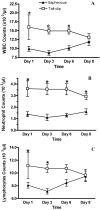Evaluation of saphenous venipuncture and modified tail-clip blood collection in mice
- PMID: 18459706
- PMCID: PMC2654012
Evaluation of saphenous venipuncture and modified tail-clip blood collection in mice
Abstract
The purpose of this study was to evaluate the effects of 2 methods of blood collection in unanesthetized mice. The saphenous venipuncture method was compared with a modified tail-clip technique that requires minimal restraint. Mice were evaluated through behavioral observation and plasma corticosterone levels. The results showed that the 2 methods produced similar corticosterone responses and that the tail-clip method produced fewer behavioral reactions. In addition, the effects of saphenous venipuncture method appeared to be dependent on the handler's technical expertise. When a series of 4 blood collections were performed over 1 wk, the 2 methods yielded similar corticosterone levels that did not increase over time. Some of the behavioral signs appeared to increase over the series of blood collections obtained by the saphenous venipuncture method. Serial complete blood counts showed that the tail vessels yielded higher total white blood cell, neutrophil, and lymphocyte counts than did the saphenous vein. Neither method appeared to cause stress-associated changes in the leukogram after serial blood collection. Overall, the effects of modified tail-clip method were similar to those of the saphenous venipuncture method in unanesthetized mice.
Figures





References
-
- Arras M, Rettich A, Seifert B, Kasermann HP, Rulicke T. 2007. Should laboratory mice be anaesthetized for tail biopsy? Lab Anim 41:30–45 - PubMed
-
- Balcombe JP, Barnard ND, Sandusky C. 2004. Laboratory routines cause animal stress. Contemp Top Lab Anim Sci 43:42–51 - PubMed
-
- De Kloet ER, Sutanto W, Rots N, van Haarst A, van den Berg D, Oitzl M, van Eekelen A, Voorhuis D. 1991. Plasticity and function of brain corticosteroid receptors during aging. Acta Endocrinol (Copenh) 125Suppl. 1:65–72 - PubMed
-
- Drozdowicz CK, Bowman TA, Webb ML, Lang CM. 1990. Effect of in-house transport on murine plasma corticosterone concentration and blood lymphocyte populations. Am J Vet Res 51:1841–1846 - PubMed
Publication types
MeSH terms
Substances
Grants and funding
LinkOut - more resources
Full Text Sources
